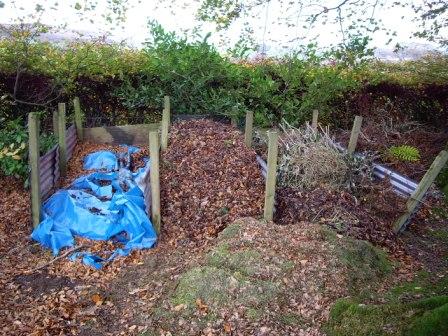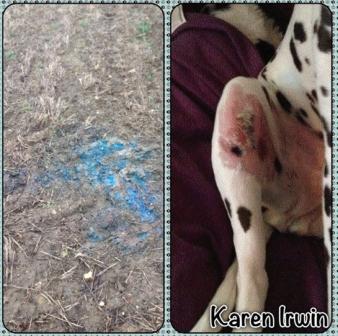
LABRADOR RETRIEVER RESCUE
SOUTHERN ENGLAND
The Danger of Compost


Composting is a great, eco-friendly way to deal with your kitchen waste. However, your composter, whether it is a back garden version or your green bin can look like a great snack to your dog, and the contents of your bin can be extremely hazardous.
Bones of all kinds can cause choking and intestinal obstructions.
Spoiled food and fats in the compost pile can also cause gastrointestinal problems, including vomiting and diarrhoea (sometimes bloody). Mouldy dairy products such as cheese, mouldy nuts such as walnuts or peanuts, mouldy grains, and pastas are often the culprits behind these issues.
Most importantly, the decaying food in compost bins, which so appeals to our canine friends, potentially contains up to twenty different kinds of mould, and many of these moulds produce mycotoxins that can have severe negative health effects.
Consuming even a small amount of mould can cause small muscle tremors and ataxia (which will cause your pet to look like he/she is drunk, staggering or having trouble walking) for a period of hours or days. Larger mould consumption can cause severe tremors, seizures and even death.
If you suspect that your pet has got into a compost pile or mouldy garbage, please get immediate veterinary attention. Depending on whether the pet is showing signs of toxicity, your dog will likely be made to vomit, to rid the system of as much of the mouldy food as possible, and then treated with activated charcoal to absorb the mycotoxins from the intestine. We never recommend inducing vomiting at home, due to possible complications, including inhalation of vomit or bloating.
In most cases, pets with mould toxicity will be kept in the hospital on IV fluids and given muscle relaxants to address any tremors, and treated for seizures if necessary. Antibiotics are also sometimes used to treat any diarrhoea. A hospital stay may range from one day to several days, depending on how much mould your pet consumed and how quickly they were treated by a veterinarian.
Of course the key to avoiding all of this is preventing your dog from eating mouldy spoiled food in the first place. Keep all compost in pet-proof containers, both in the kitchen and outside the house. Secure your garden composter with bungee cords. Avoid throwing mouldy food in your garden composter use your green bin and always secure your green bin with the locking latch.
When walking your dog, keep them away from any garbage or mouldy looking substances.
The Danger of Slug Pellets
By Karen Urwin
There is nothing better than getting up early in the morning and taking your dog for a ramble across the fields. There are many tasty things in the field that are attractive to your dog, such as dead rabbits, dead mice and even horse poo. Most of our dogs are guilty of eating such things they find on a walk but how many of you actually pay close attention to what your dog is eating? Slug pellets are commonly used in farmers' fields and just like dead animals, these pellets taste good to your dog. However the deadly toxin found in slug pellets is extremely potent and if not treated in time, can unfortunately kill your dog.
Common symptoms exhibited by a dog that has ingested slug pellets can include:
* foaming at the mouth
* weakness
* shaking
* tremors, and eventually seizures
* sickness
* emptying of the bowels
Lilly is a Dalmatian who unfortunately ingested a large amount of slug pellets and in order to try to prevent this happening to other dogs, Lilly's owner has written a blog on the events that unfolded during that day.
"I live in a rural area and at certain times of the year the farmers are busy harvesting the fields and spraying their crops.
Whilst walking my two Dalmatians on a very windy day in March this year, my eldest dally Lilly was strolling along and her head shot up as she caught the scent of something in the air. She took off across the field at full pace and I saw her stop in the distance and could see she was sniffing or eating something. My younger dally Lola decided she would join her and took off across the fields also. I was shouting for them to come back and they just would not listen, which was very unlike them. I made my way across the field shouting for them to come back and as I got close to them they did eventually.
I was so angry that they had not listened, that as punishment I put them both back on their leads and went home. After an hour or so I left the house and I retuned around 3 hours later, and when I opened my front door Lilly was lying in the hallway having a fit. Her eyes were huge and black, she had been sick, and her bowels had opened. She was foaming at the mouth and had a lot of blood around her legs. It was Sunday so the vets were closed so I had to wait for the emergency vet to call me back, and in the meantime my neighbour and I bundled her in blankets, put her in the car and drove to the vets. The younger dally Lola seemed fine, so I left her at home, and my neighbour sat with her.
The vet knew straight away that Lilly had been poisoned. She was convulsing and foaming so badly, it was truly awful. They put her on a drip and started pumping medication into her, but he basically said that they would keep her in and watch her and wait for the medication to take effect. Whilst at the vets my neighbour called and said that Lola was showing signs of being unwell, so I went home to collect her and took her to the vets also. At this stage Lola was unable to walk properly, was staggering around like she was drunk and making funny noises in her throat. She had not yet been sick, or started fitting. The vet done the same treatment for her as they were doing for Lilly, and she was able to be fed charcoal powder which helps with the poisoning. This is the first stage of the side effects, the staggering around, and sounding like somethings stuck on the throat.
I was sent home and told to await an update. 3 hours later the vet called me and said he has never seen such a bad case of poisoning, and it was very unlikely Lilly would survive the night. She was not responding to any medication and she was still fitting. Lola however was sedated and settled and was being kept on a drip through the night.
To say that was the longest night of my life is an understatement. I did not sleep at all, and felt so guilty. Why had not I checked what they had eaten? They are always picking things up, dead animals, bones etc, I guess I thought it must have been that that they had found.
The vet called me at 8am the next day and I was convinced that Lilly had died during the night. How could a dog survive something like that? However he was pleased to report that by midnight the fitting had stopped. By 2am she had rolled onto her side, and before he called me she had eaten some food and gone to the toilet. They were both kept in until the afternoon for observation, and I bought them home that evening. Lilly seemed fine when I picked her up, very excited. The blood that I had seen on her legs was actually because she had been lying on the rug when her fitting had started, and because she was laying spread eagled (as always) she had literally carpet burned her skin away. So much so it was red raw and she had to have antibiotics so it did not get infected.
When I got her home she took a turn for the worse. She completely lost all of her strength; she could not stand up and was shaking uncontrollably. I had to hold her water bowl to her face so she could drink, and she did not stop drinking all night. I was so scared that she was going to start fitting again that I was scared to go to bed and leave her. In the end I carried her upstairs (as she could not walk) and she slept in bed next to me, with my hand on her all night so that if she started fitting again it would wake me up (not that I slept much!).
By the morning she seemed a bit better, seemed stronger and ate her breakfast. Her legs were very weak still, and she could not walk properly for at least 1 week. Her legs healed up, and at her checkup 1 week later the vet was happy with her progress and did not think there would be any long-term side effects. Lola was also fine. The difference was that Lola did not eat as much as Lilly, so the effects of it took longer to come out, which was lucky.
Big lesson learnt for me. I now ALWAYS check if I see them eating something now, and if it is something that I do not recognise then I will take them to the vets straight away, as they can make them sick to bring up whatever they have eaten before it gets into their system. Vet bill for both was not as bad as I thought it would be, I think it was around £700 for both of them. Considering I had to pay for an emergency call out, and Lilly had to have someone with her all night, I was expecting it to be much more".
